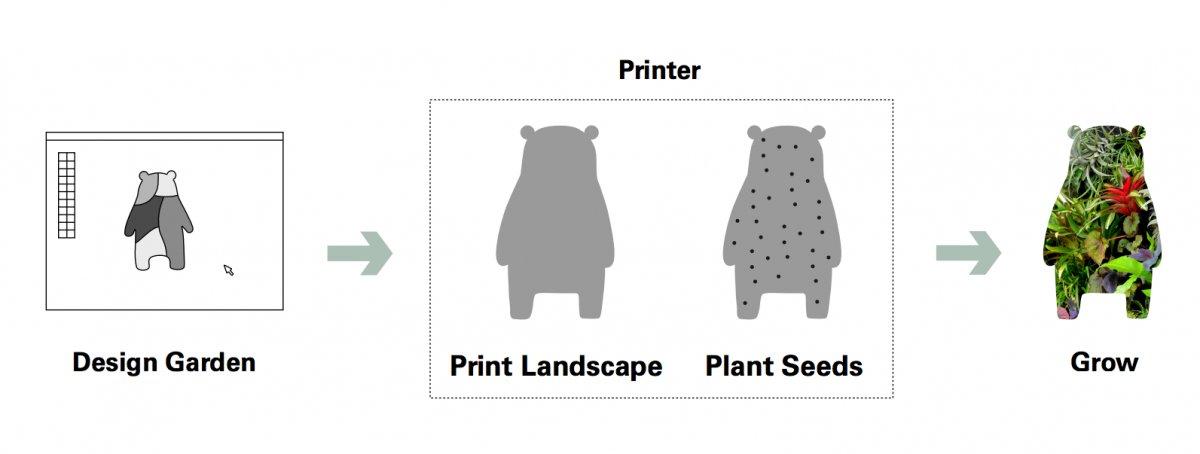Imagine a garden springing from your 3D printer, herbs and flowers flourishing in a matter of weeks, creating a lush, green space on your balcony or your rooftop. Yuichiro Takeuchi, a computer scientist with Sony Computer Science Laboratories, Inc. in Tokyo, Japan, has found a way to print the foundations of a garden using a 3D printer and software of his own design.
Takeuchi uses a 3D printer to create yarn encasements containing seeds. His method is based on hydroponics, a system of cultivating plants in water with the use of mineral nutrient solutions. No soil is needed, which makes this method ideal for urban spaces like rooftops, atriums, balconies, and so forth. Because of the yarn mesh, the plants can also be grown on vertical surfaces with certain adjustments.
Takeuchi’s software allows you to design your garden in any shape you wish, making it more or less complicated. For instance, he created a garden in the shape of a panda. Currently, the computer scientist and fledgling gardener is growing smaller plants such as watercress as wells a edibles like basil and arugula. However, he aims to expand on his design in order to produce yarn encasements big enough to yield vegetables, fruit, and even trees. This will require a larger, faster printer, and he is working toward that particular goal at the moment.
Takeuchi premiered his 3D gardening method in late September this year at the Sony Computer Science Laboratories (CSL) Symposium at the Museum of Modern Art in New York City. He envisions converting his home city, Tokyo, into a garden city, a greening up that New York and other large urban centers could also use. Since plants clean the air, Takeuchi believes that creating such urban green spaces is one forward-thinking way to reduce carbon levels in cities.
The Tokyo native also provided another, more fanciful reason for promoting his do-it-yourself urban gardens, particularly in Tokyo: “Here in Japan we love fireflies,” he explained. “As they can only thrive in pristine environments we don’t see them in dense, built-up Tokyo.” It is this nature-loving computer scientist’s hope that urban gardens will provide habitats for fireflies and other wildlife that otherwise would not thrive in the city environment. This could as well be a boon for the bee population, which is currently under threat. Additionally, urban gardens allow city-dwellers to cultivate some of their own food, getting a taste of the rural life while still enjoying the pleasures of life in the big city. Additional details on these 3D gardens, and be found in the 3D Printed Garden forum thread on 3DPB.com.

Podcast: Play in new window | Download
Subscribe to Our Email Newsletter
Stay up-to-date on all the latest news from the 3D printing industry and receive information and offers from third party vendors.
You May Also Like
Printing Money Episode 17: Recent 3D Printing Deals, with Alex Kingsbury
Printing Money is back with Episode 17! Our host, NewCap Partners‘ Danny Piper, is joined by Alex Kingsbury for this episode, so you can prepare yourself for smart coverage laced...
Insights from Cantor Fitzgerald on AM’s Q1 2024 Landscape
A recent survey by Cantor Fitzgerald sheds light on the persistent challenges within the additive manufacturing (AM) industry in the first quarter of 2024. Based on responses from 38 industry...
3D Printing Financials: Xometry’s Scaling up and Strong Start to 2024
Xometry (Nasdaq: XMTR) kicked off 2024 with strong results, boosting its marketplace and technology to new heights. Both revenue and gross margin soared, fueled by an expanding global network of...
3D Printing Financials: Desktop Metal Targets Recovery Amid Net Losses and Revenue Downturn
Despite facing a decline in revenue and the persistent challenges of a tight economic climate, Desktop Metal (NYSE: DM) is making strides toward operational efficiency. The first quarter of 2024...

































